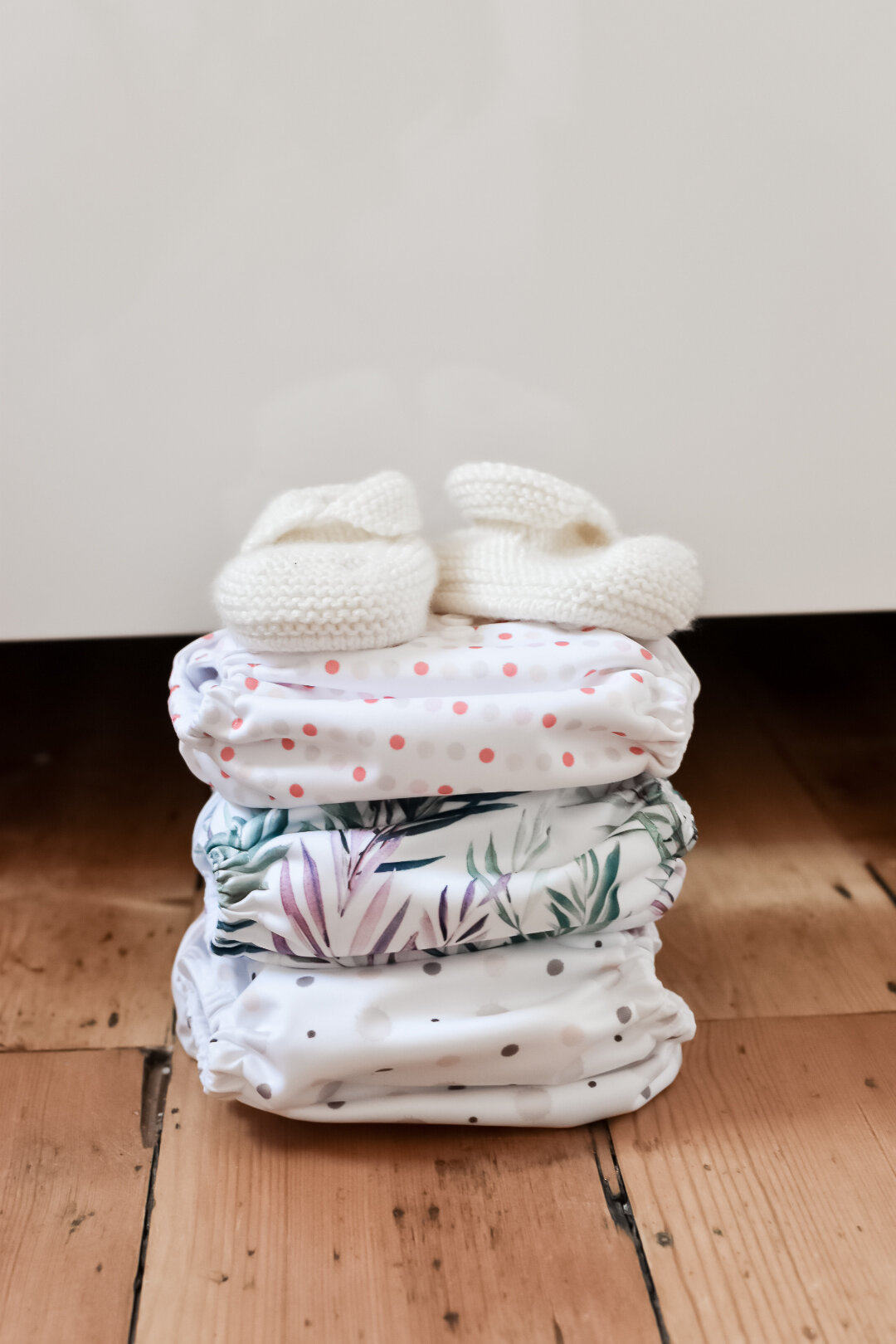5 Reasons your Cloth Nappies are Leaking (and How to Solve Them!)
There’s lots to love about cloth nappies. They’re wonderful for the environment, they’re gentle on tiny bottoms, and they’re beautiful to boot. But when you first get started with them, there can be a little bit of a learning curve as you figure out which nappies work for you.
Although many people get on well with cloth from day one, some people struggle with leaks to begin with and can’t work out why. Others will have got on fine with reusable nappies for a while, and suddenly start springing leaks out of nowhere. This is one of the most common questions that people ask me, so I’ve put together a checklist of the top five reasons why your nappies might be leaking, and how you can solve them.
These five reasons are responsible for most of the issues people experience. Handily, you can remember them as ABCDE!
Absorbency
Bad fit
Compression
Damage
Excess product
Ok, so some of them are a bit of a stretch, but hopefully it’s a little bit helpful!
Generally it’s a good idea to consider the potential problems in roughly this order too. So don’t go worrying about damage to your nappies until you’ve worked out if you’ve got enough absorbency. In each area, I’ll give you some easy ways to tell whether that issue might be responsible for those pesky leaks.
Firstly though, I want to tackle one important question…
Is your nappy actually leaking?
Reusable nappies aren’t as absorbent as disposable nappies. They don’t have any of the chemical nasties that make disposable nappies super thirsty, so they naturally won’t last as long. Generally, you should expect your nappies to last 2-3 hours before a change. Any less than this and you may well have a leak problem to solve! However, if your nappies are lasting at least two hours, you can still try working through the solutions I’m suggesting, though they may not make a huge difference.
Ok, on to the solutions!
Reason #1 : Absorbency
What’s the issue?
Some babies wee a lot, and some much less, so naturally different babies need different amounts of absorbency. Not all nappies have the same capacity. Some are highly absorbent, while others less so (usually those that are a bit slimmer).
Some nappies leak simply because little one is weeing too much for the nappy to cope with. You can tell if this issue by checking how damp the absorbent part of the nappy is when you remove it. If it’s completely saturated within 2 hours, you may need a more absorbent nappy.
How do I solve it?
Before you go out and buy a whole new nappy stash, there are a couple of things to check.
Firstly, check whether you have pre-washed your nappies enough times. Nappies made of natural fibres like bamboo, hemp and cotton will need up to eight washes to reach full absorbency. Until then, you might need to plan to change little one’s nappy more often.
Secondly, consider boosting your nappies with a slim absorbent bamboo booster like this one from Little Lambs. This will help you to tell whether absorbency really is the issue. Also, some kiddos go through a temporary phase of wetting more, before decreasing again. For example, some babies wet through just before they start weaning, only for the problem to resolve itself once they’re on solids. So it’s best to try boosting for a while. If the problem really isn’t improving, at that stage you may want to consider a different, more absorbent nappy.
My guide to nighttime nappies has even more information on absorbency, including how absorbent different nappy styles and materials are.
Reason #2: Bad fit
What’s the issue?
Reusable nappies fit slightly differently to disposable nappies, and often a poor fit will lead to leaks. Whilst getting the fit right can take a couple of goes, it’s very easy once you’re used to it. This is also the most common cause of poo leaks. With a good fit, reusable nappies almost never leak poo (even those crazy newborn poonamis!) so if that’s an issue for you, it’s most like a fit issue.
How do I solve it?
I have a detailed YouTube video that guides you through fitting three different styles of nappy, which you can watch below. You can also contact me for a fit check.
Reason #3: Compression
What’s the issue?
Some nappies act a little like a sponge, and will leak when they’re squeezed. So if little one is in a car seat, sling, or there’s a tight vest pressing on the nappy, it might leak under the pressure. Certain nappies are more prone to this than others, with the worst offenders being nappies that are made of microfibre.
How do I solve it?
Don’t let this put you off easily-compressed fibres like microfibre altogether. They’re excellent as long as they’re used alongside another high capacity absorber like bamboo. So, for example, if your pocket nappy comes with a microfibre booster, replace it with a booster that’s a combination of microfibre and bamboo. Another solution is to have bamboo nappies set aside for times compression leaks are likely, such as long car journeys. This is more difficult if little one is always in the sling!
If your compression leaks are down to tight clothing, consider using vest extenders for vests, or look into companies that make clothing that is specifically cut for cloth.
Use vest extenders for vests, or try clothing that is ‘cut for cloth’
Reason #4: Damage
What’s the issue?
Sometimes nappies leak simply because they’re broken. The most obvious issues here are holes or damage to the waterproof layer of the nappy (if it has one!) and stretched elastics. This might be the first thing you think of when you get leaks, but it’s actually relatively rare unless your nappies are faulty or pretty old. That’s why it’s number four on the list of things to check!
The most reliable way to tell if the waterproofing has gone on your nappy is to do the ‘tea towel test’. Here’s how to do it.
You will need:
2 tea towels or muslins
The nappy/wrap you’re testing (clean and dry)
Lay out one of your towels or muslins on a clean, dry waterproof surface (a kitchen counter is ideal). Place your nappy on top, open, with the inside facing up.
Fold your second towel/muslin into a rectangle that will fit inside the nappy without touching the edges.
Wet this folded towel so that it is very damp to the touch but not dripping and then place it on top of your open nappy, making sure that it is well away from the edges of the nappy. Take a look at the pictures below to see what I mean. The test won’t be reliable if the towel has leaked around the edge of the nappy, so you need to make sure it sits well inside.
Leave for 30 minutes to an hour.
After this time, if your bottom tea towel is at all damp, it means that your waterproofing has failed. The area where the dampness is usually corresponds to where the hole or damage is. If the tea towel is still completely dry, then your waterproofing is fine.
To check if your elastics are gone, you can simply stretch them and see how much give is still in them. If they’re gone, they will feel slack and not springy.
How do I solve it?
Unfortunately there’s no long term fix for failed waterproofing. Usually the best route is to give your nappy a new life as a doll nappy, or to cut out any absorbent pieces and use it as a swim nappy.
Elastics, on the other hand, can be rescued. On most nappies it’s possible to sew in new elastics with basic sewing skills. You could even take them to a seamstress to replace.
Reason #5: Excess product
What’s the issue?
This is probably the least common reason for leaks, but there are occasions where it’s an issue, so I thought it was worth a mention. The fibres inside your nappies are there to absorb liquid, but sometimes a build-up of products on the fibres can prevent them from doing their job. The most common offenders are fabric softeners, nappy creams and an excess of detergent.
With any of these products, issues will only arise if you’re using them repeatedly over a pretty long period of time. So if your mother-in-law accidentally adds fabric softener to your wash as a one off, don’t panic! Just make sure it doesn’t become a recurring event.
How do I solve it?
If you’ve got a build-up of detergent, cream or fabric softener, you will need to remove it by doing a strip wash. You can find instructions for strip washing over at my guide to nappy washing.
You’ll then need to make sure that you’re preventing further build-up in future. Here’s what to do:
Fabric softener - You shouldn’t be regularly adding fabric softener to your nappy wash. If you’re not adding it yourself, make sure you check that your washing detergent doesn’t have it in. Some ‘2 in 1’ style detergents have added softener.
Nappy creams - The vast majority of nappy creams are ‘barrier creams’, where they’re designed to prevent the movement of moisture. On a baby’s bottom this works great, as it keeps them dry, but if those creams are regularly getting onto your nappy, they can build-up and reduce absorbency over time. You can use most creams safely if you add either a fleece or disposable liner to your nappy. Some creams can even be used safely without a liner, such as the Balmonds Baby Balm or good old coconut oil.
Detergent - Use the correct amount of detergent for heavy soiling, the size of your drum and water hardness. Typically people underdose rather than overdose, but occasionally overdosing can happen, particularly where people move house into an area where the water hardness is very different, or they have a different size washing machine. Double check exactly the amount you should be using, and then use that amount going forward to avoid any issues with build-up.
What to do if you’re still getting leaks
There are some occasions where you just can’t figure out what’s going on, and if that’s the case, do get in touch for some help!
Most importantly, don’t despair if you’re getting recurring leaks! All problems are solvable, so keep persevering, ask for help, and if you need a break, you can always switch to disposables for a short while. Life is too short to be stressed about nappies!
This page contains affiliate links, which earn me a little bit of commission if you make a purchase, at no additional cost to you. Thank you!
If you found this post helpful, please consider buying me a coffee!







